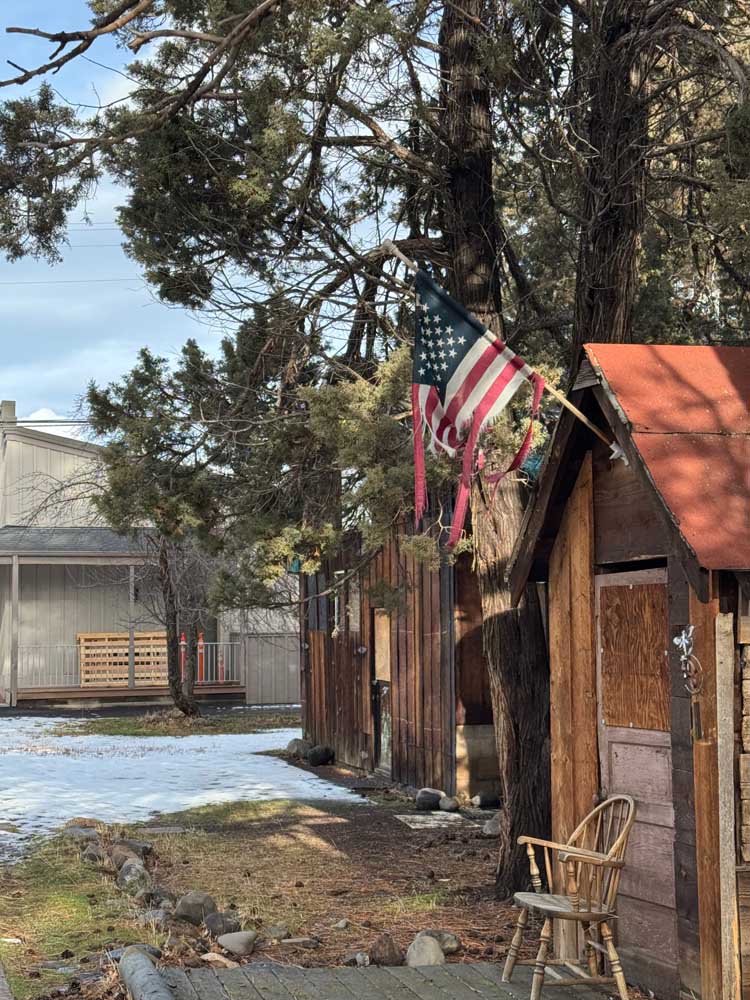For a wintry weekend hike, hit the streets of Sisters
Published 6:00 am Thursday, January 9, 2025

- A patriotic (if tattered) salute seen along an alley one block south of Highway 20 in Sisters.
When the COVID-19 pandemic sequestered many of us into our homes and neighborhoods for months at a time, walking without destination was fashionable. The virus barred us from bars and restaurants and gyms, and ambling became our recreation, our exercise, and our source for improving our mental health.
Five years after the pandemic started, the art of the urban sashay need not go away just because the gyms and hiking trails are back in use. Particularly in January, when many hiking trails are either too muddy or too snowy for responsible use in a pair of New Balance shoes, the neighborhood traipse is a better option. That’s why, on a mild January Sunday, I leashed up my black lab and took to the streets.
In writing about urban hiking, I want to clarify that I’m not about to review the exquisite Larkspur Trail in southeast Bend or direct you to Pilot Butte for a hill workout. I’m talking about hoofing it in your neighborhood.
Pedestrians in my town of Sisters are spoiled by deferential drivers. Much of the U.S. is paved over, with cars the dominant means of travel, so not everywhere allows for the step-minded among us to safely shuffle about. Most of Central Oregon is blessed with strong pedestrian infrastructure and sidewalks, thus the responsible thing to do is take advantage of it.
Rinse off the workweek ick with nighttime skiing at Hoodoo
“Fifteen-minute cities” is a concept that has gained traction among urban planners for years, and Sisters contains a lot of what they had in mind. As the name suggests, “15-minute cities” is the term for an urban setting where a 15-minute walk, bike ride or public transportation ride can bring you to all of your day’s needs: food, education, health care facilities and work.
My neighborhood is about a 5-minute walk from groceries, schools, a fitness center, an optometrist, a hardware store and multiple fast-food options. I’m a mere 15-minute walk from downtown, and Sisters’ plethora of espresso, pastries, steaks, ice cream and music venues. Even with no destination in mind, it is nice to know I live near so many.
Urban walks need not be a meditation on concrete alone. In many Central Oregon neighborhoods, nature is incorporated into the urban landscape. Green space has been a priority of planners here for decades. The parks, trees and even tiny roundabout island eco-systems are proof of that. Walking down a residential neighborhood in any Central Oregon city includes the risk of coming face to face with black-tailed deer, gray squirrels, scrub jays, marmots and coyotes. Cougars have even been sighted within some city limits.
The Village Green, in the heart of Sisters, might be our most well-known park. It has hosted many artists during past Sisters Folk Festival runs. When the concerts aren’t bumping, it hosts a playground, large gazebo, and a huge lawn where dogs become acquainted with each other and crows bounce around in pursuit of food.
The best way to observe nature in your city is to forego those earbuds and let in the sounds of the neighborhood. (The NPR podcast can wait — chipmunks are talking.) From my house in northwest Sisters all the way to downtown, I heard squirrels rustling and stellar jays shrieking. While most of our town’s drivers are polite, it’s helpful to be all-ears when you’re walking on very old surface streets without sidewalks so you can hug the shoulder when vehicles pass.
Downtown Sisters includes some buildings that are a century old, and homes with Depression-era history. Incorporated in 1946, but settled decades before, Sisters was primarily a “sawmill city” until the timber industry began to wane in the 1960s. Many older homes in south downtown could have been the residence of a sawmill worker and their family.
Most, however, have been replaced with custom builds, tiny homes, cottage clusters and skinny townhomes. Towering ponderosas frame most of the downtown area south of U.S. Highway 20, and a couple of undeveloped lots are prime real estate for deer who bed down for the evening, though less often in winter.
The secret of this walkable, park-like setting may be out. On my trip, bundled-up walkers and their dogs numbered in the dozens near the neighborhoods of Washington Avenue and Ash Street. Some may be locals, though it’s a good bet that others are coming from Sisters Coffee Company, judging by their beverages in hand. Hood Avenue is a popular commercial section that breaks up the residential gridlock with independent art dealers, bookstores and caffeinated drinks. All this can be done while avoiding congested East Cascade Avenue (Highway 20’s path through downtown).
Don’t neglect a good alley, either. Some of the most memorable finds within a city are in the alleys, safe from heavy traffic and prying eyes. I will never forget one spring seeing a very young, heavily spotted fawn and its family (including one deer with a visibly broken ankle) taking a respite in an alley between Elm Street and Ash Street. It’s a helpful reminder that even on public rights of way, in a city surrounded by forests, we are the trespassers.








